Retail Store Layout Optimization with Video Analytics

SVP, Engineering
Retail Store Layout Optimization with Video Analytics
Introduction
What is Retail Store Layout?
Retail store layout refers to how brick-and-mortar retailers set up product displays, fixtures, and merchandise in their stores. A well-planned store layout can positively influence customer experience, a critical factor to drive product engagement, sales, and improve customer lifetime value.
Retailers have several tools to gather and analyze data to understand if the store layout is working well and identify problem areas that need optimization. Some of these tools include store audits, mystery shopping, and customer surveys or shopper feedback.
However, there are three fundamental limitations of using these measurement techniques for evaluating store layout effectiveness.
- Some of the observations may be subjective or subject to interpretation.
- Observations or feedback from a customer or from a store audit may or may not be consistently true across all locations or at all times.
- There is no way to access real-time data on store layout performance using any of these traditional measurement methods.
Video analytics addresses these limitations as it is driven by aggregated data, captured and processed in real-time, at all locations where the store layout is being monitored.
That’s not all. Video analytics can be implemented by leveraging security cameras that the store may already have in place. Click here to learn more about video analytics.
In this blog post, we will explore how retail chains can optimize store layout using video analytics.
Types of Retail Store Layouts
Grid Layout
Pros:
Easy navigation for customers.
Efficient use of space, allowing for a high product density.
Simplifies inventory management and restocking.
Cons:
Lack of uniqueness in design.
Limited opportunities to create focal points or highlight specific products.
Example: Large format retailers like Walmart and Target often adopt a grid layout to streamline the shopping experience and accommodate a vast array of products.
Loop or Racetrack Layout
Pros:
Encourages exploration as customers follow a predefined path.
Promotes impulse buying with strategically placed displays.
Ideal for larger stores with a wide product range.
Cons:
Potential for congestion and bottlenecks, especially during peak hours.
Limited flexibility in creating distinct shopping zones.
Example: IKEA, a furniture and home goods retailer, utilizes a loop layout, guiding customers through various showroom sections and strategically placing smaller items in the pathway to encourage additional purchases.
Free-Flow Layout
Pros:
Offers a relaxed and casual shopping environment.
Encourages creativity in display and decor.
Allows for easy adaptation to changing merchandise or seasonal themes.
Cons:
Challenges in guiding customer flow and promoting specific product areas.
Risk of customers missing certain sections of the store
Example: Apple Stores, known for their electronics and tech products, often feature a free-flow layout, allowing customers to interact freely with products, creating a more personalized and engaging experience.
Angular Layout
Pros: Creates a visually interesting and dynamic store design. Facilitates the establishment of distinct departments or product categories. Encourages customers to explore different sections of the store.
Cons: Requires careful planning to avoid confusing navigation. May result in underutilized space in corners and angular areas.
Example: Zara, a fast-fashion retailer, often employs an angular layout to create visually striking displays and highlight specific clothing collections.
Geographic Layout
Pros: Organizes products based on their intended use or category. Provides a logical and intuitive shopping experience. Enhances the customer’s ability to find specific items easily.
Cons: Limited flexibility in adapting to changing merchandise or promotional displays. Challenges in creating a visually appealing overall store design.
Example: Best Buy, specializing in electronics and appliances, organizes its stores based on product categories, adopting a geographic layout to simplify the customer’s search for specific items.
Mixed-Use Layout
Pros:
Combines elements of different layouts for a customized approach.
Offers flexibility to cater to various product categories.
Allows for creative and innovative store design solutions.
Cons:
Requires careful planning to maintain a cohesive and harmonious overall look.
Potential for confusion if not executed seamlessly.
Example: Sephora, a beauty and cosmetics retailer, often adopts a mixed-use layout. The store seamlessly integrates grid-like shelving for a wide range of products, while also incorporating free-flowing beauty stations that encourage customers to experiment with makeup and skincare products, creating an interactive and personalized shopping experience.
Significance of retail store layout
Before we explore the various strategies to deploy video analytics for measuring store layout effectiveness, let’s understand how retail layout has a direct impact on customer satisfaction and store performance.
1. Create a great customer experience
The massive shift to ecommerce and BOPIS (Buy Online and Pickup in Store) has turned the spotlight on in-store customer experience.
Even pure-play ecommerce brands like Amazon are opening brick-and-mortar locations to offer customers the experience of traditional shopping with never-before-seen convenience.
Customer experience is probably the single most important tool that brick and mortar retailers can use to give customers enough reasons to come back to the store boosting chances for engagement and conversion.
Retail chains with the capability to measure and monitor changes in customer experience can make changes in the store layout so that product categories that are in high demand can gain prominence.
REI has created a unique in-store experience that includes a combination of interactive displays, expert sales staff, and in-store activities that give customers who enjoy the outdoor lifestyle plenty of reasons to visit an REI store.
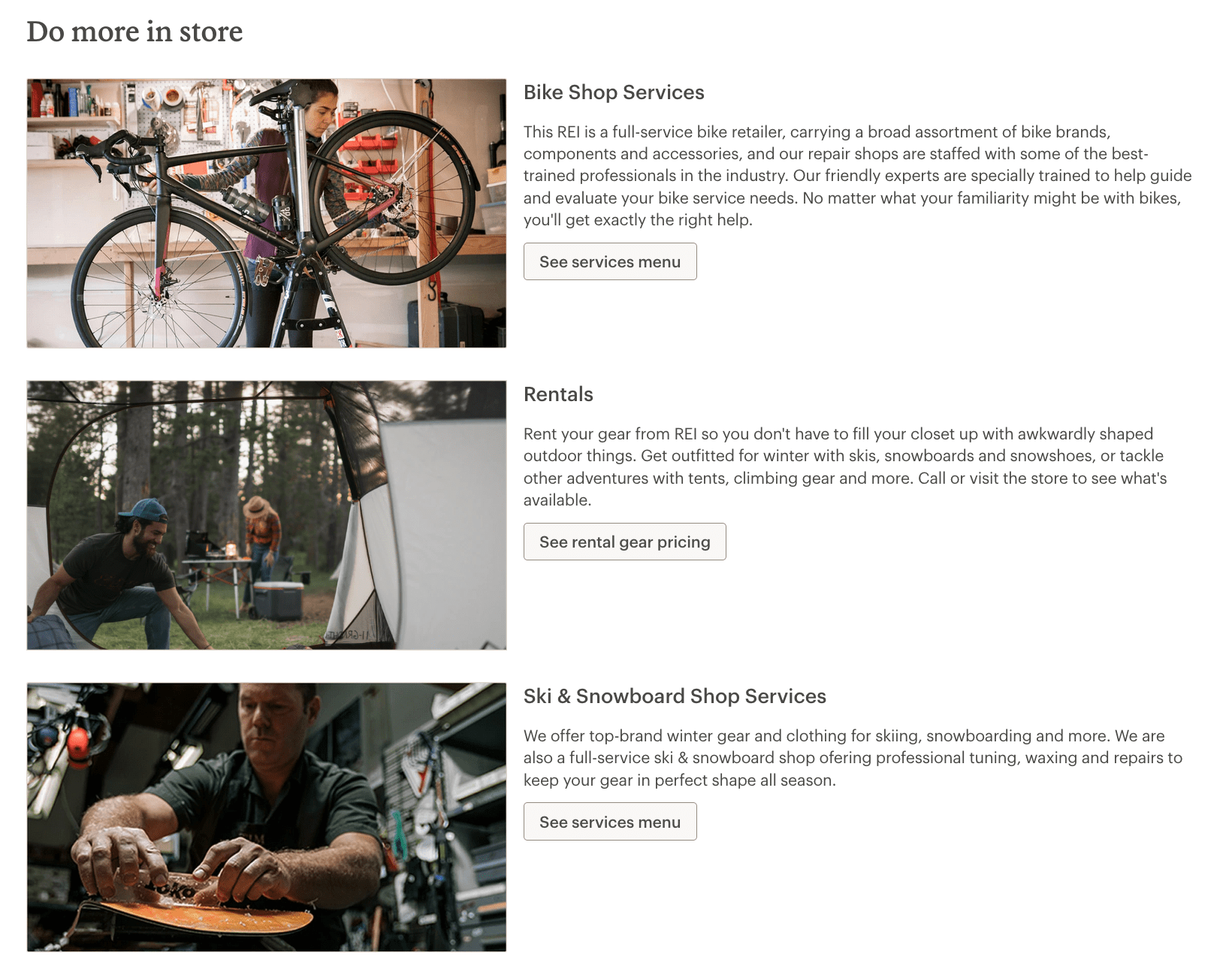
2. Increase sales
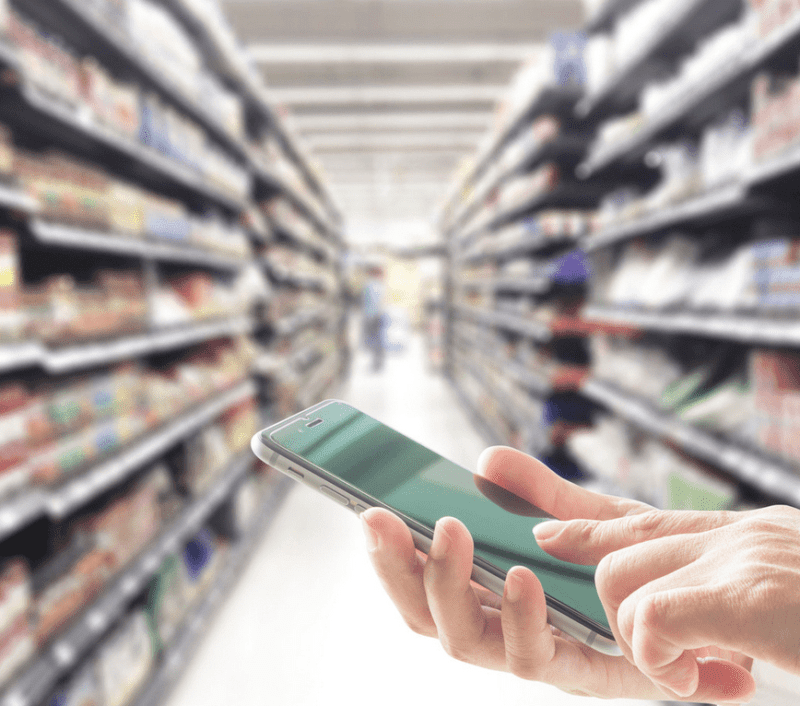
Customer Mission: I need to wrap up shopping before the meeting.
How Store Layout Can Help: Layout that places popular product categories prominently
Store map at entrance: Improved signage for all departments with popular products listed on the signage
Customer expectations, needs, and wants are dynamic and retailers with the ability to optimize and reinvent store layout can turn challenges into new sales opportunities.
For example, putting BOPIS or click-and-collect counters near the store entrance makes it more likely that customers will use this service in the future, helping retailers capture more of this market in the future. Since the click-and-collect market in the U.S. is forecast to grow to $120 billion and beyond by 2023, this type of store layout option can increase overall sales dramatically for retailers.
3. Manage stock more efficiently
Managing space optimally can maximize sales, minimize stockouts. improve employee productivity and align with the objectives of the store itself.
For example, a store that’s designed to introduce new products and carry little inventory is designed to maximize product engagement with checkout counters taking the backseat completely as employees focus on product engagement and possibly help customers place online orders at the store. A classic example of a store design that focuses on product engagement is the Apple store.
A store that’s focused on convenience and breadth of assortment such as a specialty grocery store has to be designed for easy access and having enough space for carrying all the assortments.
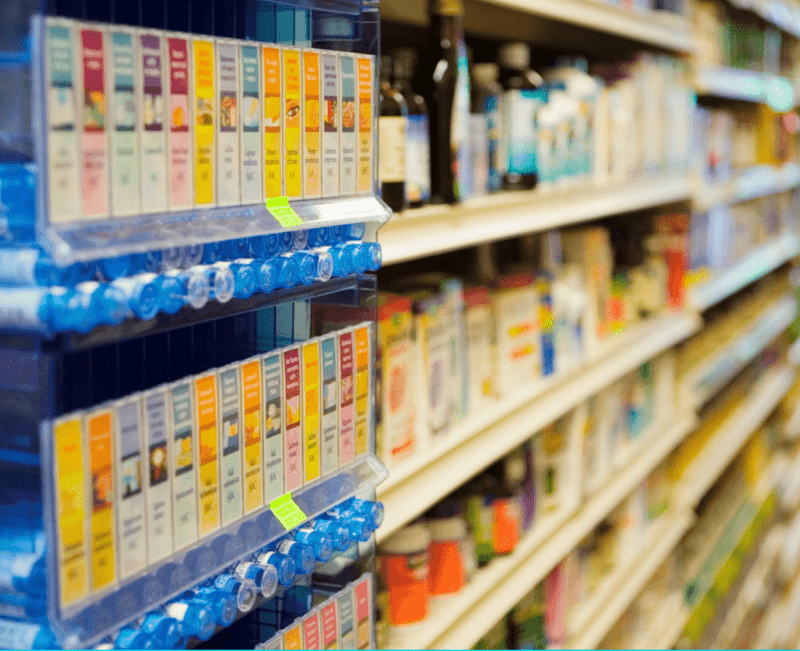
Trader Joe’s small format stores focus on convenience and quick access to a wide variety of specialized grocery and food items. Their design is easy to work with not only for customers but also for employees. Their inventory management and ordering is perfectly timed with demand and shelf breaches (items being placed outside the designated areas) or prolonged stockouts is never a problem as the store layout gives easy visual and physical access to all aisles.
4. Minimize theft
According to the 2020 NRF Security Survey, retail shrink is at an all-time high, accounting for 1.62% of a retailer’s bottom line — costing the industry $61.7 billion. While retailers use a variety of technology solutions such as video surveillance, protective display cases with locks, chords, EAS (electronic article surveillance), retail store layout is one of the many factors that determine the success of loss prevention efforts.
Some of the store layout and design principles that minimize theft and an assortment of inventory losses include:
- A design that offers a clear line of sight for employees at the checkout counters to all parts of the store.
- A layout that doesn’t obstruct camera views or signals from EAS installations.
- A layout that avoids cramped spaces and allows employees to identify misplaced items quickly.
- A design with well-planned exits that minimizes chances of snatch and grab thefts.
5. Improve safety and accessibility
Safe retail store design keeps employees safe from environmental and health hazards. A store layout that’s accessible ensures anyone can access the store regardless of ability.
Depending on a store location, any retail layout has to comply with regulations and policies associated with safety, security, and accessibility.
A well-designed retail store will take into consideration a number of design parameters that directly impact safety and accessibility. Here are some examples:
- A store layout with aisles and customer paths wide enough to accommodate wheelchairs with adequate ramps and accessible facilities throughout the store.
- Ergonomically designed display units or shelving to prevent injuries for customers or employees handling the product.
- Store layout designed for proper airflow and ventilation throughout.
- Stores with properly designed flooring and elevated platforms to avoid trips or falls.
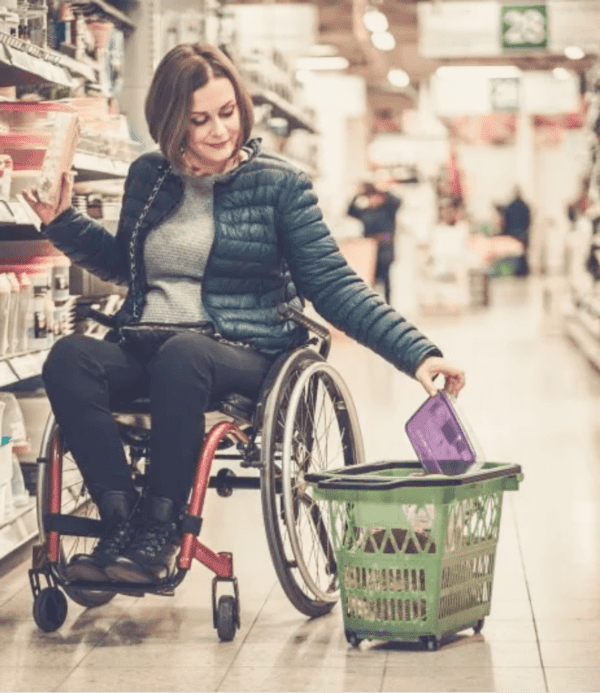
Designing an accessible store layout is good business. According to the United States Department of Justice, “More than 50 million Americans with disabilities are potential customers for retail businesses across the country. These 50-million-plus customers, along with their families and friends, patronize clothing boutiques, mall outlets, grocery stores, and more, if the businesses are accessible. This market grows even larger if the 78 million baby boomers in this country – who do not always require but benefit from accessibility – are included. Accessibility makes good business sense: an accessible retail establishment brings in new customers and keeps them coming back again and again.”
Store layout optimization strategies using video analytics
1. Streamline customer flow
Video analytics is well suited to map and measure customer flows through the store. Understanding customer flow helps retailers evaluate the effectiveness of the store layout, understand the best possible placement of products, measure customer actions at every section or department, measure the impact of specialized displays, in-store promotions, or marketing campaigns, to name a few.
Video analytics, when combined with POS data, can help retailers conduct a real-time audit of the store layout to identify bottlenecks in the design, and align the layout to help customers successfully accomplish their shopping missions.
Here are some of the ways video analytics can help retailers troubleshoot store layout issues to improve customer experience and revenues:
- Use pathmap metrics to understand how customers move around in the store. Redesign the store layout or make changes to problem areas in the store to drive desired customer actions such as better footfalls in previously low activity areas or reorganize the placement of products to help customers get what they want faster.
- Identify and eliminate ‘dead zones’ in terms of footfall activity or engagement and take remedial actions such as better signage, lighting, or a redesigned layout.
- Use traffic data at store entrance and exits or department/category entry and exits to measure overall or department/category level conversion metrics. Analyze conversion metrics together with other factors that determine conversions such as weather or seasons. Test hypothesis on reasons for conversion with a/b testing spanning layout, product placements, promotions, or in-store displays/announcements.
- Track dwell time across the store to understand customer interest in specific products as well as flow bottlenecks that force customers to wait longer than expected such as in the checkout areas. Use these insights to offer more products that customers want or reorganize the checkout flow to reduce wait time.
- Dwell times at entrances of different departments can measure bounce rates and call attention to better product placement, staff engagement to bring guests further into the store.
Store floor plans dictate customer flow and how customers interact with the products. Irrespective of the type of store layout or floor plan (grid layout, herringbone, free-flow, geometric, mixed, to name a few), video analytics can play an important role in uncovering real-time business intelligence on how the layout is performing. The pathmap overlay on the video stream from the overhead camera offers valuable data on how the layout is impacting customer flow through the store.

2. Delight customers with a better checkout experience
The last impression is probably the best impression for retail chains looking to provide a memorable customer experience. A long checkout queue can completely wipe out any positive experience customers might have had at the store before they wanted to checkout. In some cases, customers in a hurry can just abandon their carts and never return to the store!
Retailers have already implemented an assortment of improvements to make the checkout process efficient. These include changes in how queues are organized, self-checkout kiosks, app-based self-checkout, shelves near the checkout counters to entice impulse purchases, to keep the process predictable and customers engaged as they wait for their turn to pay.
Video analytics can help retailers use real-time data to understand what’s really happening at the checkout area.
- Because video analytics offers vital video “evidence” that retailers can see first hand to understand queue efficiency and cart abandonment.
- Video analytics can identify dwell times at queues to calculate the average waiting time for a customer and use the data to plan for additional checkout lanes or self-checkout counters in addition to ramping up staffing levels to meet periodic demand surges.
- With video analytics, retailers have the flexibility to conduct data-driven tests when making significant changes to the checkout area design flow before rolling it out to the rest of the stores. The impact of layout changes on the average transaction value and items per transaction can help retailers take a decision on the revamped store layout.
Here is an example of a report from Interface’s video analytics solution that provides average dwell time waiting in queue and the average time at the checkout counter. This data can be viewed in the context of how effective a new checkout experience or layout is. In addition, this data can be mapped to other factors such as time of day, day of the week, holidays or staffing levels:
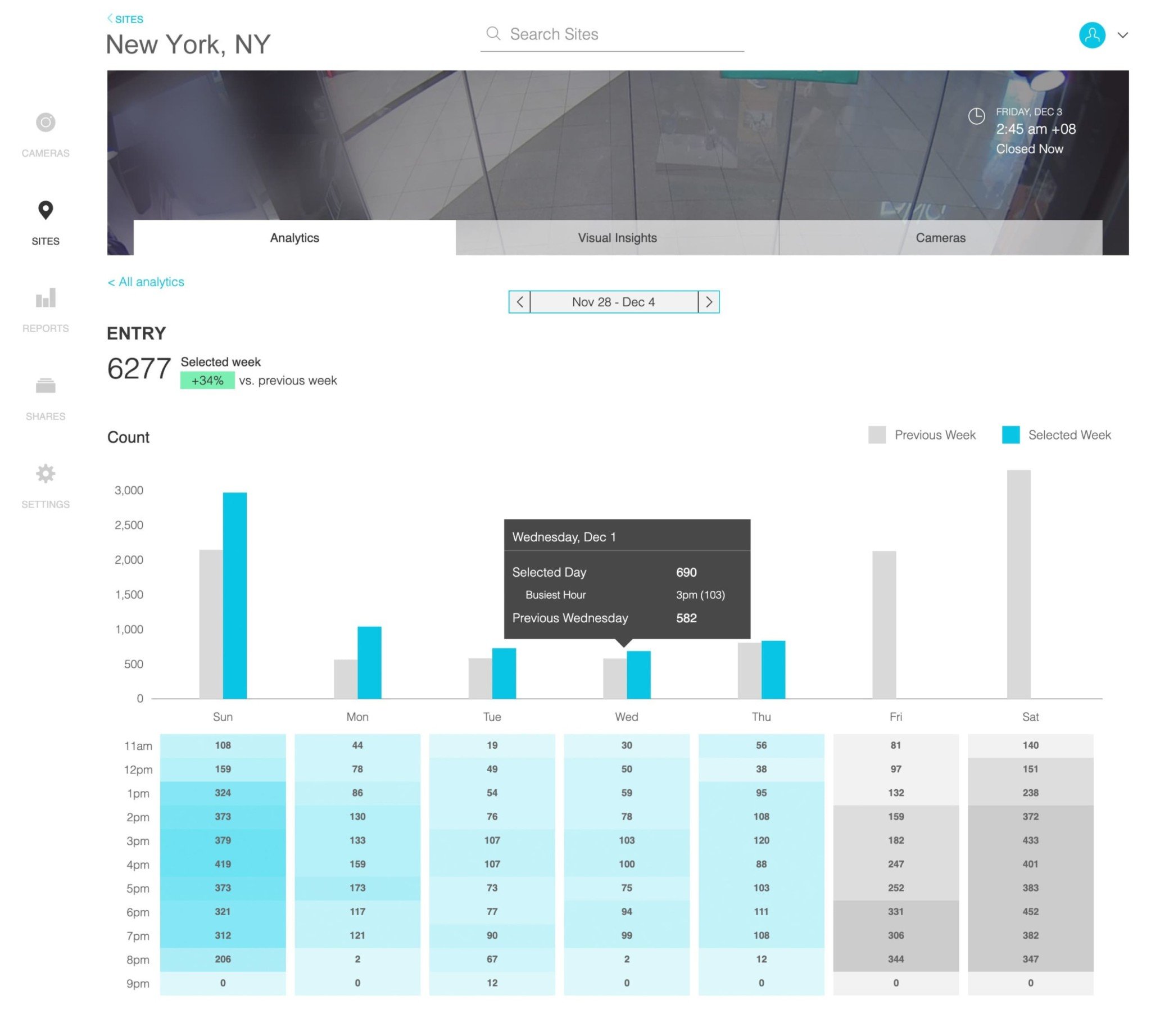
3. Improve product placement
Product placement is probably one of the most important factors that impact retail sales and is closely tied to the store layout.
While planograms offer the template to slot products in the shelf space, real-time data-driven decisions can help retailers maximize sales by aligning shelf space to customer preferences and other factors that drive purchases such as the weather or local events.
Video analytics can be a game-changer in giving retailers instant visibility on potential product placement issues and identifying opportunities to maximize basket size.
Some of the insights retail video analytics can uncover to improve product placements include:
- Hotspots around display units and shelves to precisely identify the products that customers are looking at or interacting with. This allows the retailers to identify products that need to be relocated to boost sales or change the assortment around the hotspots to promote cross-sell.
- Retailers can look at dwell time data to understand what might be causing customers to interact with the products in shelves with high dwell times and find a correlation to other factors such as time of the day, packaging, marketing campaigns (in-store or online), or any other factor that might be driving increased dwell time.
Retailers with data on the performance of shelf space across product categories and departments can optimize the store layout and display units or even change the design of the store to offer most product categories the best possible exposure to customers.
Video analytics can empower local teams to make store layout decisions based on real-time data while ensuring planogram compliance or even using data as evidence to change the planogram.
Here is a heatmap view from video analytics that precisely highlights the product displays that attracted maximum customer interactions or engagement. Using this data in conjunction with sales data or marketing campaign calendar can uncover challenges and opportunities with the product placement tactics or even store layout changes to improve performance.
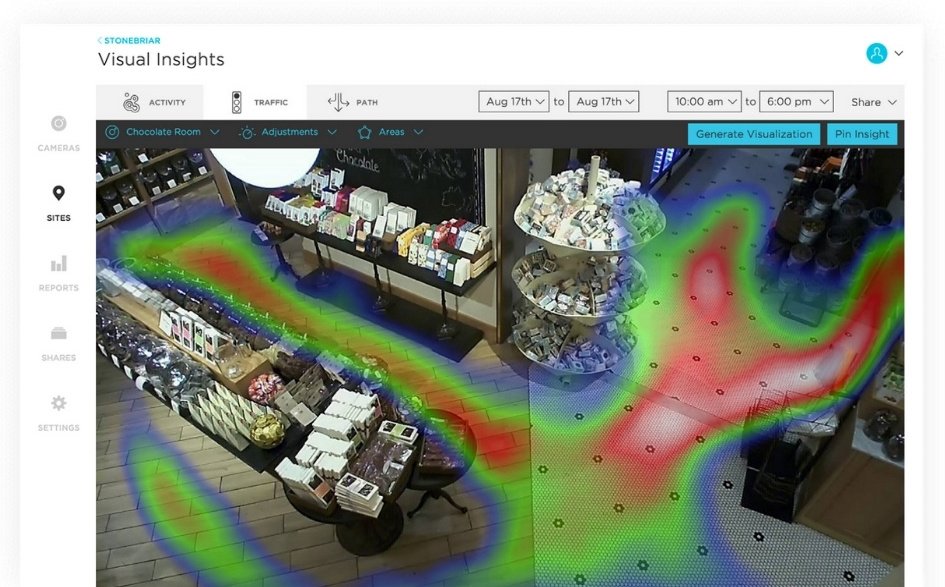
4. A/B test store design or layout changes
The practice of A/B testing is a common practice to test or validate ecommerce sites and online experiences. With video analytics, retailers have the capability to conduct real-time, data-driven A/B tests to validate the effectiveness of the store layout or a specific component such as a brand new display unit measured in terms of dwell time, heatmaps, and sales conversions.
In addition, video analytics also allows retailers to A/B test the effectiveness of store design on new customer behaviors such as BOPIS. For example, video analytics can help find answers to questions like “Would it make sense to design the in-store pickup area to showcase products that are not available online?”.
Here are four different product display designs and the associated pathmaps of customers interacting with the displays generated by the Interface video analytics solution
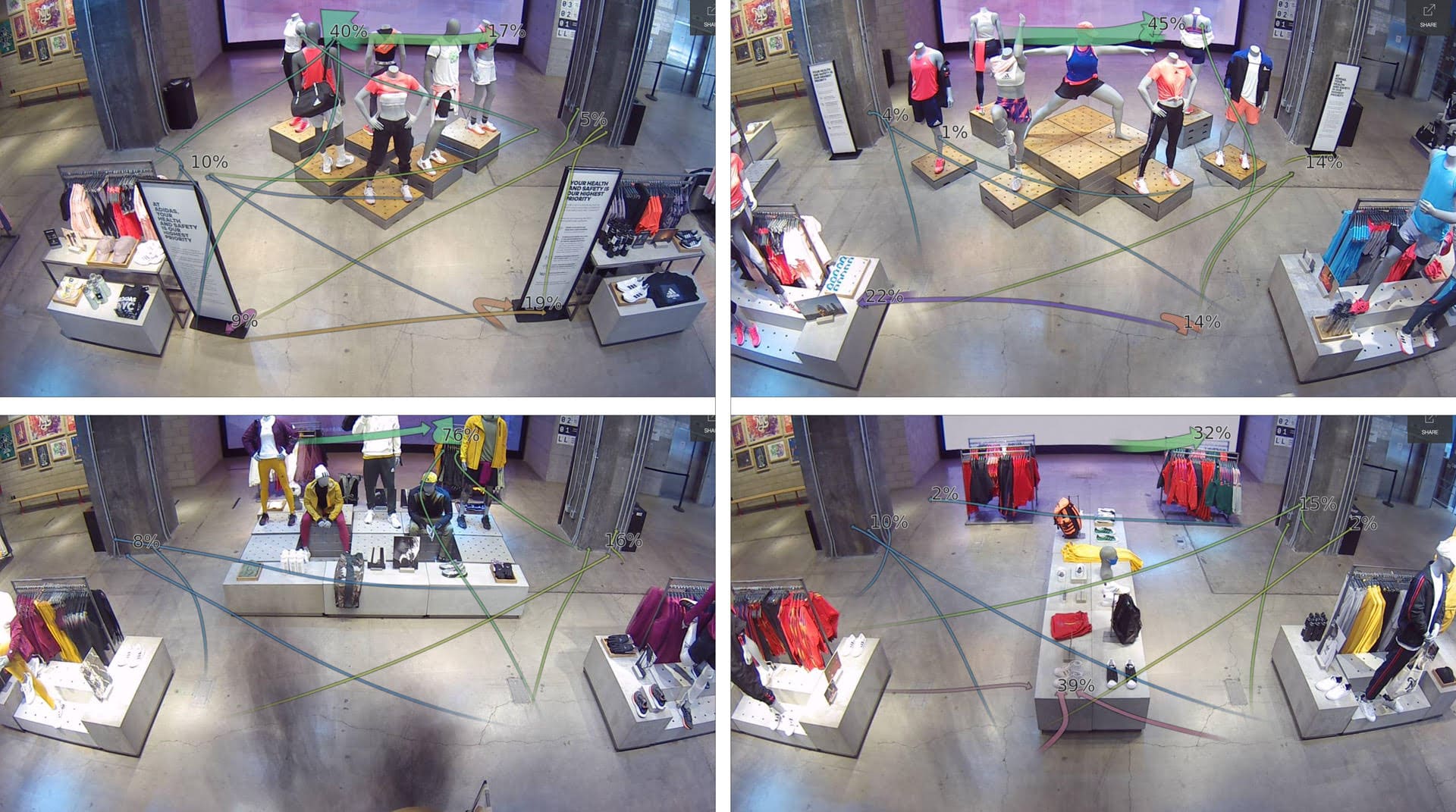
With video analytics, retailers have the flexibility to test any number of store layout or design variations across multiple locations at a time. This is a useful feature that allows retailers to
- Conduct multivariate A/B tests with the right sample size
- Ensure tests run for the required duration to reach the threshold KPI uplift
5. Supercharge merchandising tactics
The merchandising function is at crossroads as retailers scramble to offer an omnichannel customer experience and stay ahead of evolving customer expectations. Technology solutions, like video analytics, can play a significant role in helping merchandising teams recalibrate their priorities, and become agile to keep pace with changes.
According to McKinsey, the merchandising function will be driven by automation and here is how video analytics can help enable the transition to agile merchandising.
Here is an example of customer engagement data for a display unit. Merchandisers can use this insight to manage shelf-level displays or even floor layouts. In addition, inventory checks and audits can be done in real time without waiting for onsite audits.
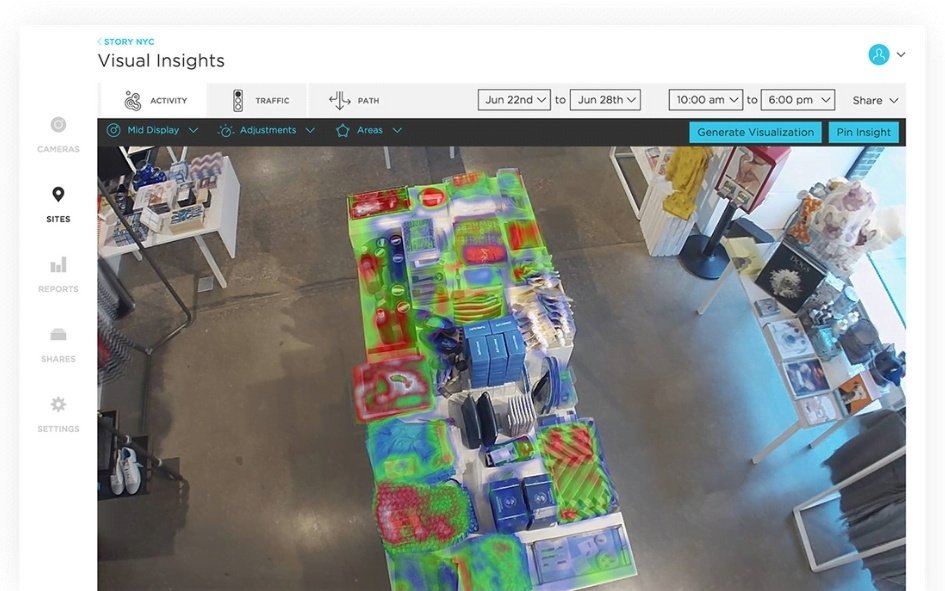
6. Improve storefront design
Storefront design has always been a major factor in retail success. When done right, creative storefronts make new customers feel curious and existing customers satisfied with their choice.
Video analytics can help retailers gather valuable data to improve the performance of storefront design.
- Heatmaps and dwell times can be used to understand which display elements are attracting attention.
- Changes in display design or layout can be put through an A/B test to measure improvements in engagement and walk-ins.
- Pathmaps can show how many people walk past the storefront (bounce rate) and what percentage of people walking by enter the store.
- All of the above insights can be correlated to other data such as holidays, time of day, day of the week, promotions, online campaigns to name a few to give a better insight on storefront designs that encourage desired customer behavior.
Different storefront window treatments can have their effectiveness measured via customer entry counts.
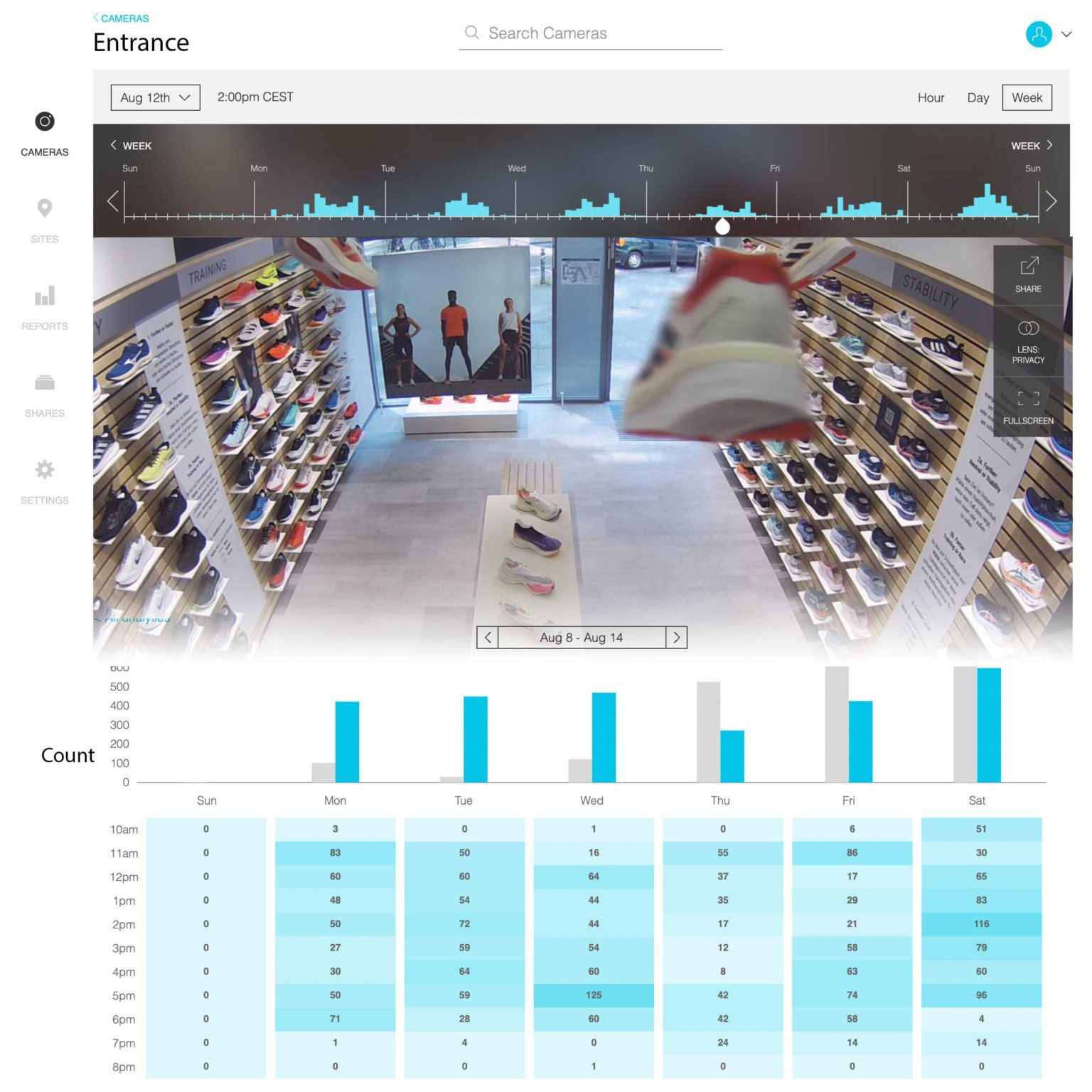
7. Ensure layout and design compliance
There are three reasons why store layout and design compliance is a major operational requirement in retail chains:
- One of the key promises of a brand is delivering consistency at every touchpoint. In-store design and layout is an important factor that helps retailers create a unique yet consistent experience for customers.
- Layout and design compliance is also a key requirement for brands that may have paid for premium shelf space or set up special display areas. Retailers rely on physical in-store audits to verify design or layout compliance across stores.
- Ensuring that the store layout does not cause unintended issues such as closed spaces, bottlenecks, or blocks access to lighting or surveillance which might contribute to poor safety or health hazards for employees and customers.
Video analytics offers retail compliance, marketing, and merchandising teams monitor store layout and design compliance at scale across a large number of locations. The screenshot below demonstrates how Interface’s video analytics solution enables a visual verification of layout and design compliance across stores.
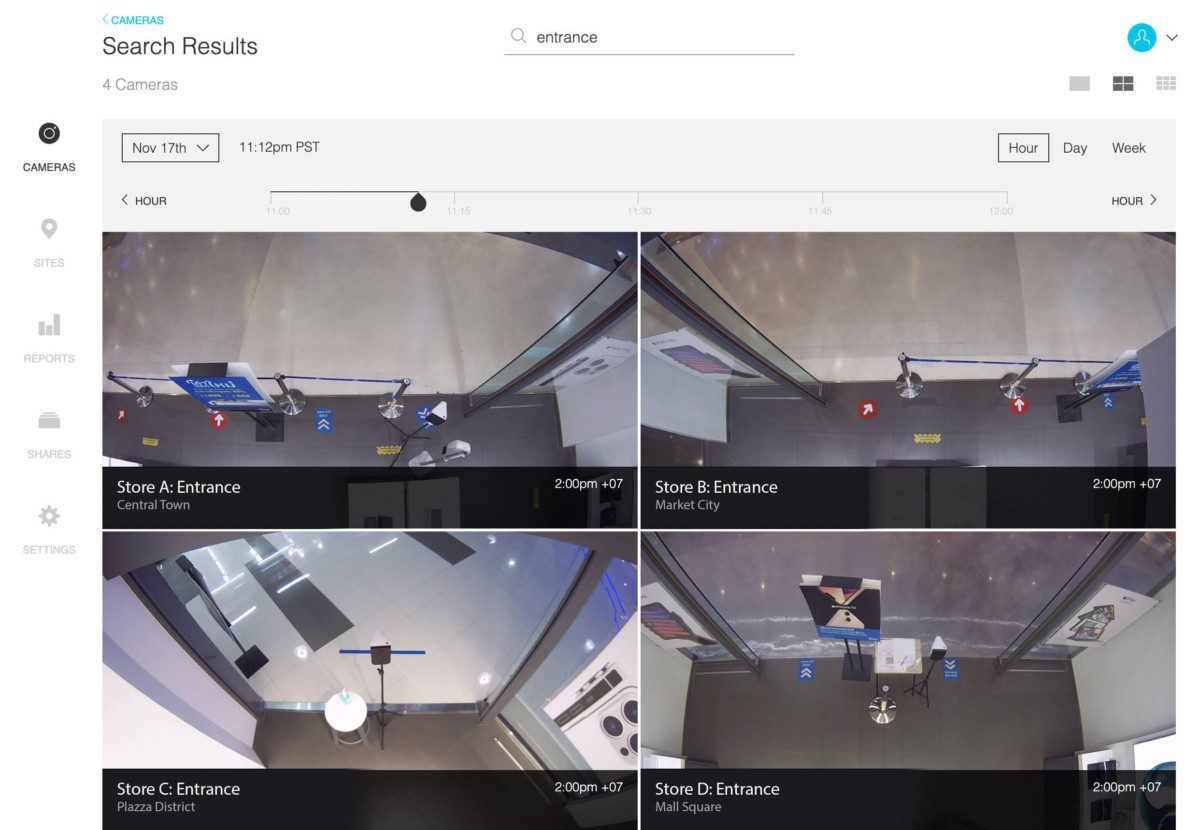
In addition to monitoring layout compliance in real-time with no need for physical audits, store managers can use video analytics to spot maintenance issues, identify stockouts, and validate if compliance violations are fixed properly.
Share this article
Transform retail operations with video analytics
About the author

Steve Womer
SVP, Engineering
Explore more blog articles
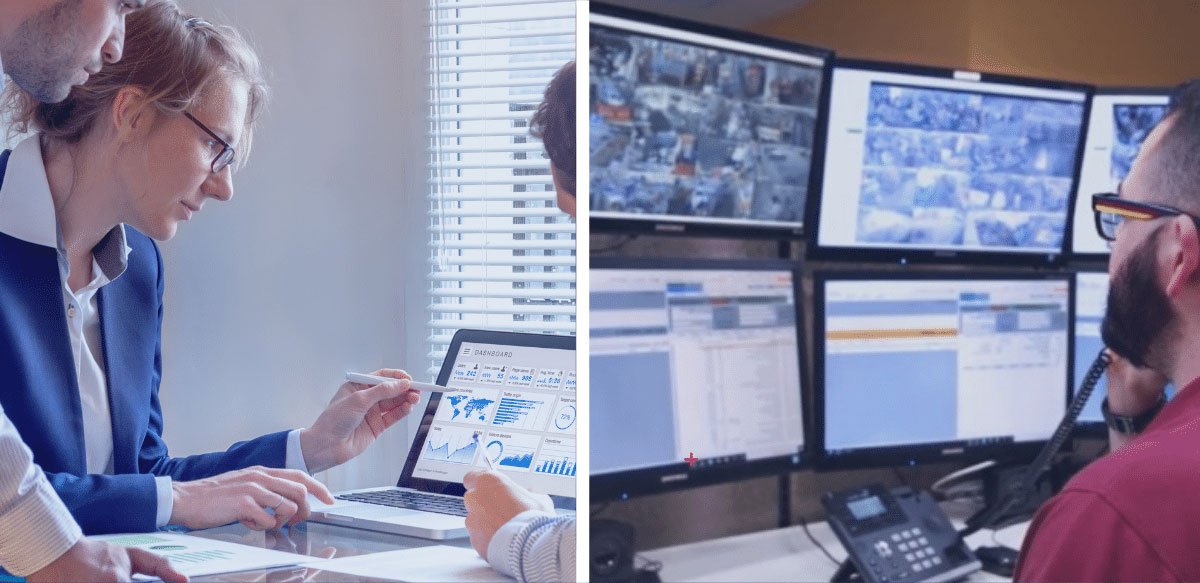
Business Video Surveillance Insights for Loss Prevention Teams
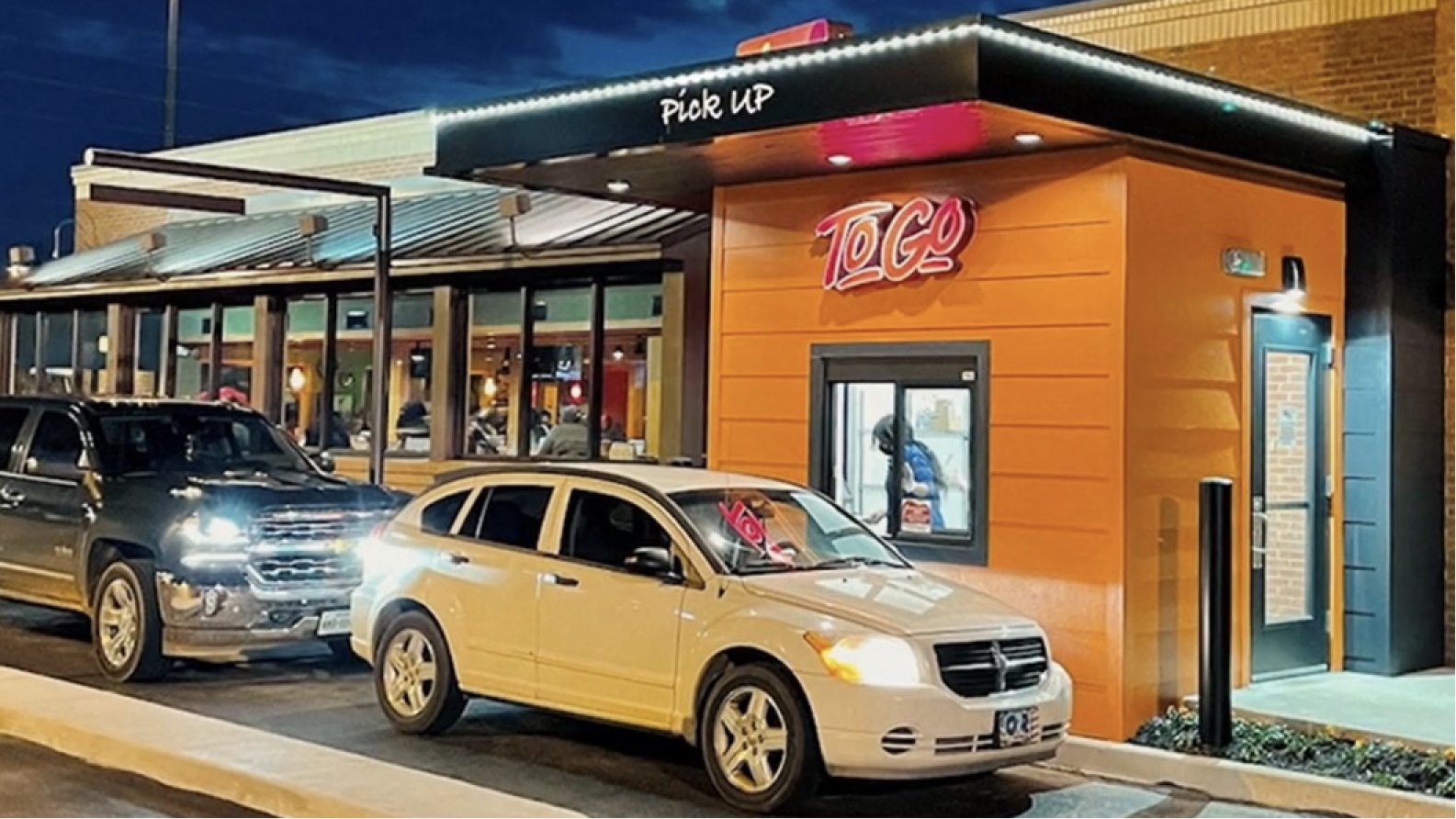
7 Groundbreaking Drive-Thru Concepts and Trends for QSRs in 2024
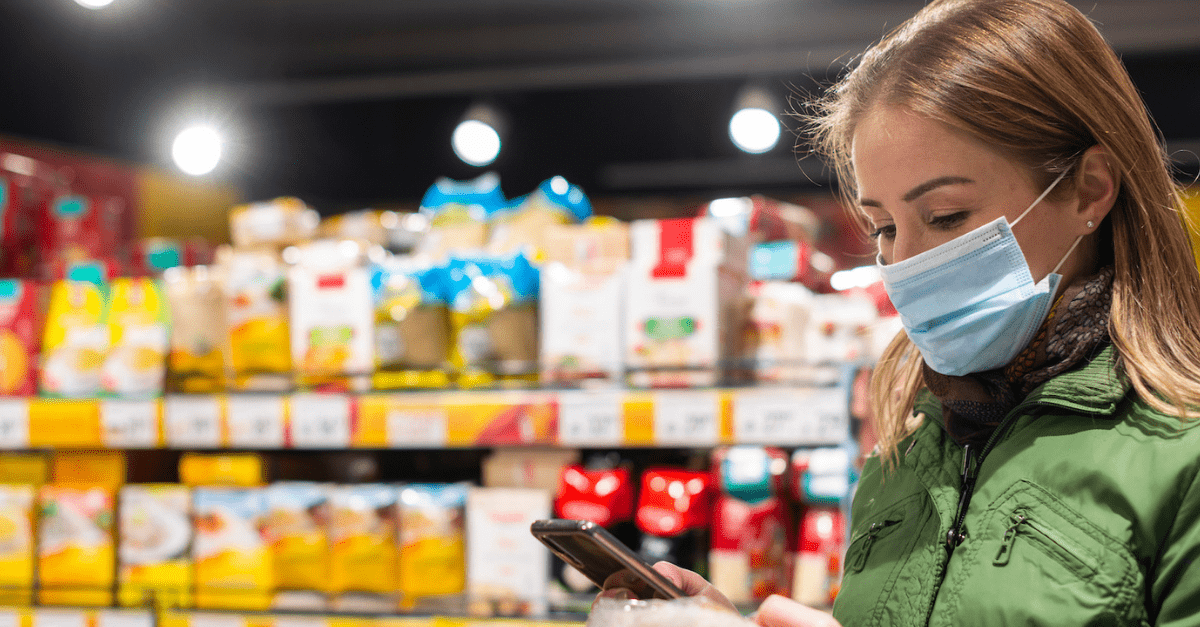
Retail Network Transformational Insights
Connect with Our Experts
Interface solution experts are ready to help you solve challenges. Set up a no-obligation, exploratory call now.